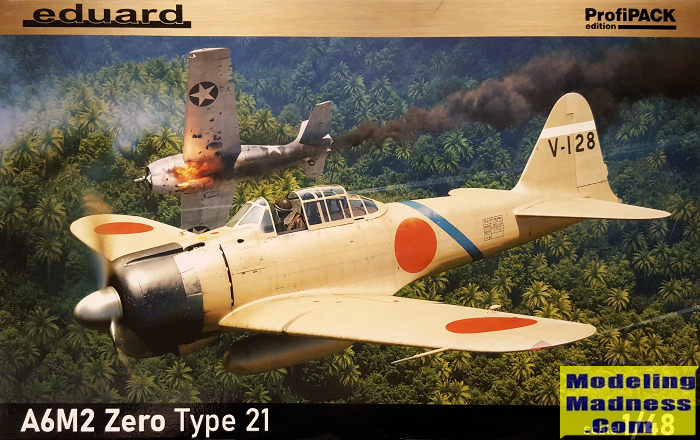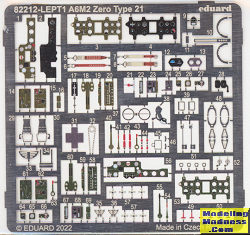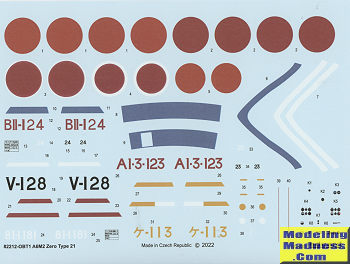
Eduard 1/48 A6M2 type 21
| KIT #: | 82212 |
| PRICE: | $53.18 delivered from the UK |
| DECALS: | Five options |
| REVIEWER: | Scott Van Aken |
| NOTES: | 2022 release. Profipack |

| HISTORY |
While the navy was testing the first two A6M prototypes, they suggested that the third be fitted with the 700 kW (940 hp) Nakajima Sakae 12 engine instead. Mitsubishi had its own engine of this class in the form of the Kinsei, so they were somewhat reluctant to use the Sakae. Nevertheless, when the first A6M2 was completed in January 1940, the Sakae's extra power pushed the performance of the Zero well past the original specifications.
The new version was so promising that the Navy had 15 built and shipped to China before they had completed testing. They arrived in Manchuria in July 1940, and first saw combat over Chungking in August. There they proved to be completely untouchable by the Polikarpov I-16s and I-153s that had been such a problem for the A5Ms when in service. In one encounter, 13 Zeros shot down 27 I-15s and I-16s in under three minutes without loss. After hearing of these reports, the navy immediately ordered the A6M2 into production as the Type 0 Carrier Fighter, Model 11. Reports of the Zero's performance filtered back to the US slowly. There they were dismissed by most military officials, who thought it was impossible for the Japanese to build such an aircraft. All Model 11 aircraft were land based.
After the delivery of the 65th aircraft, a further change was worked into the production lines, which introduced folding wingtips to allow them to fit on aircraft carriers. The resulting Model 21 would become one of the most produced versions early in the war. A feature was the improved range with 520 l (140 US gal) wing tank and 320 l (85 US gal) drop tank. When the lines switched to updated models, 740 Model 21s had been completed by Mitsubishi, and another 800 by Nakajima. Two other versions of the Model 21 were built in small numbers, the Nakajima-built A6M2-N "Rufe" floatplane (based on the Model 11 with a slightly modified tail), and the A6M2-K two-seat trainer of which a total of 508 were built by Hitachi and the Sasebo Naval Air Arsenal.
| THE KIT |
 Despite
there being good kits of the A6M from both Hasegawa and Tamiya, Eduard has
taken the plunge into doing this aircraft. It is probably because they see
the opportunity for good sales as the Zero is one of the best selling WWII
aircraft kits. Eduard is also doing a Wildcat later on so it seems their
focus is turning to the Pacific War.
Despite
there being good kits of the A6M from both Hasegawa and Tamiya, Eduard has
taken the plunge into doing this aircraft. It is probably because they see
the opportunity for good sales as the Zero is one of the best selling WWII
aircraft kits. Eduard is also doing a Wildcat later on so it seems their
focus is turning to the Pacific War.  The
cockpit is quite complete, with all the various sidewall items being
separate, some that consist of several pieces. As this is a Profipack
boxing, there are alternate p.e. items. For instruments, p.e. replaces the
decals. You can, however, use the decals if you so desire. You also don't
have to use all the p.e. as some items will be easier for the builder to
install without it. Note also that there are differences in some interior
items between the various markings options so if using kit decals (and I see
no reason not to), you need to know which one you'll be building fairly
early in construction.
The
cockpit is quite complete, with all the various sidewall items being
separate, some that consist of several pieces. As this is a Profipack
boxing, there are alternate p.e. items. For instruments, p.e. replaces the
decals. You can, however, use the decals if you so desire. You also don't
have to use all the p.e. as some items will be easier for the builder to
install without it. Note also that there are differences in some interior
items between the various markings options so if using kit decals (and I see
no reason not to), you need to know which one you'll be building fairly
early in construction.  You are
provided two tail hook options, one raised and one lowered. Note that some
land based planes had this removed to save weight. For things under wings,
you are provided a drop tank and bombs depending on the markings option
you'll be using. Also an option are wing mass balances and prop spinners.
When attaching the canopy to the cockpit greenhouse, you are provided two
options here as well. One for open and the other for closed. Eduard has
included one of the canopy mask sets to help deal with the greenhouse.
Another note is that not all options use the radio mast as Japanese radios
were fairly unreliable and were often removed.
You are
provided two tail hook options, one raised and one lowered. Note that some
land based planes had this removed to save weight. For things under wings,
you are provided a drop tank and bombs depending on the markings option
you'll be using. Also an option are wing mass balances and prop spinners.
When attaching the canopy to the cockpit greenhouse, you are provided two
options here as well. One for open and the other for closed. Eduard has
included one of the canopy mask sets to help deal with the greenhouse.
Another note is that not all options use the radio mast as Japanese radios
were fairly unreliable and were often removed. 
| CONCLUSIONS |
Typical of Eduard kits, this one looks as if it will be a fussy build, especially if you use all the photo etch. If you don't care about the p.e. or the canopy mask, then wait for the weekend version and save yourself a few dollars. Those who build a lot of Eduard kits are quite pleased about having this one as an alternative as it does provide a bit more detail. Now Zero modelers have another choice and having choices is not a bad thing.
| REFERENCES |
https://en.wikipedia.org/wiki/Mitsubishi_A6M_Zero#A6M2b_Type_0_Model_21
May 2022 Copyright ModelingMadness.com. All rights reserved. No
reproduction in part or in whole without express permission from the editor. If you would like your product reviewed fairly and fairly quickly, please
contact
the editor
or see other details in the
Note to
Contributors.